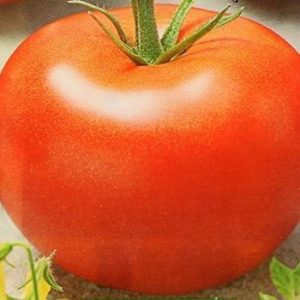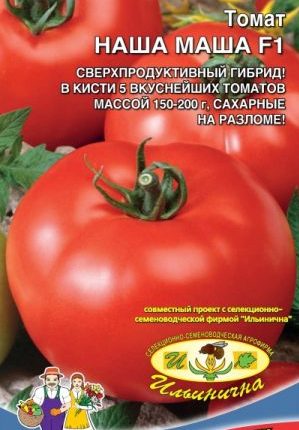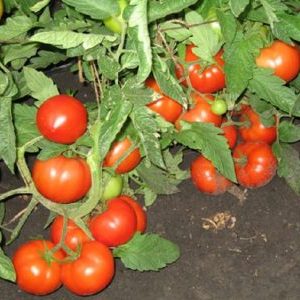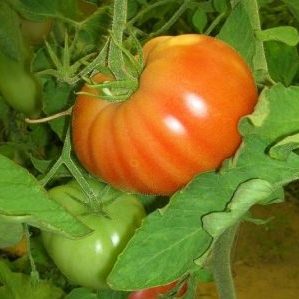A beginner's guide: growing a hybrid tomato "Nasha Masha f1"
An unpretentious, weather-resistant tomato Nasha Masha f1 was bred by Russian breeders and entered the State Register in 2002. Originator - Agrofirm "Ilyinichna" from the city of Mytishchi.
Knowledge of the peculiarities of growing this crop and proper care for it allow you to remove up to 10 kg of tasty fruits from 1 m2 of the plot.
The content of the article
Feature and Description
Hybrid Our Masha is a medium-early high-yielding crop recommended for growing in greenhouses. Subject to correct agricultural technology, vegetables are grown in the open field.
Distinctive features
Characteristic features of a hybrid:
- bush height - 1.6-1.7 m;
- stalks are dense, strong;
- medium-sized leaves;
- the growth of shoots is unlimited;
- the first inflorescence is formed over the 10th leaf;
- in total, 7-8 fruitful brushes are laid on the bush, one every 3 leaves;
- the bunch consists of 5-6 fruits;
- weight of one fruit - up to 180 g;
- from germination of seeds to ripening of fruits, 100–104 days pass.
The hybrid is resistant to fusarium, tobacco mosaic virus, cladosporium, tolerates extreme conditions, stress, temperature changes and lack of light well.
Fruit characteristics
High-yielding culture: up to 10 kg of tomatoes are harvested from 1 m2 of plot under optimal cultivation conditions.
The fruits possess:
- bright red;
- round or slightly square;
- smooth texture;
- thick skin;
- pronounced tomato flavor.
At the break, the tomatoes are sugar-rich, in taste the sweetness prevails over the sourness. The weight of one fruit is up to 200 g.
How to plant seedlings

Hybrid Our Masha is grown in seedlings, which allows you to form a powerful root system in young bushes and speed up the harvest. Seeds are planted 60–65 days before the expected dive into the ground.
Average sowing times:
- for the southern regions of Russia - end of February - first half of March;
- for the central ones - the second half of March;
- for the northern ones - the beginning of April.
Seed preparation
The seed is pre-soaked in a growth stimulator so that the seedlings appear together, and the percentage of germination is high. Use "Zircon", "Epin-Extra", "Eco-gel", following the instructions on the package.
The manufacturer processes the hybrid seeds himself, but for additional disinfection, the seed is kept in a solution of potassium permanganate (30 minutes), then dried in the sun.
Attention! Self-harvested seeds are not suitable: the second generation of hybrid tomatoes differs from the first in characteristics. Producers obtain seed by crossing parental varieties.
Soil and capacity
For sowing you will need:
- shallow plastic containers or boxes (7–10 cm) with drainage holes in the bottom;
- transparent film or glass according to the size of containers;
- soil disinfected with potassium permanganate or using high temperature.
For seedlings, they acquire a universal soil mixture or prepare a substrate independently from peat, river sand and sod land in equal proportions.
Sowing
Sowing tomatoes is carried out according to the scheme:
- The container is filled with soil, lightly tamped.
- Make grooves with a depth of 2 cm at a distance of 3-4 cm from each other.
- Seeds are placed at the bottom of the grooves one at a time, after 1-2 cm.
- The grooves are covered with soil, watered with a small amount of water.
- Cover the container with plastic or glass that allows sunlight to pass through.
The seeds are germinated at a temperature of + 25 ... + 30 ° С. The containers are placed near the battery or radiator, while maintaining high humidity under the film and sealing the container.
The first shoots appear 3-5 days after sowing. If the temperature is below +20 ° С, the terms increase.
Seedling care
As soon as the first shoots appear, the film is removed, and the container is placed in a well-lit place. For seedlings to be strong, the length of daylight hours should be 16 hours. Phytolamps are additionally used.
In the early stages, seedlings are watered gently, at the root, using a pipette or syringe. The top layer of the soil must remain moist. Only warm, settled water is suitable.
Important! If the temperature in the room drops at night, it is better to transfer watering to the morning so that the fungus does not multiply in the soil.
With the appearance of the first pair of true leaves, the seedlings dive into separate containers, preferably directly into peat pots. This will allow in the future not to injure the root system when transplanting to a permanent place. It is important to dive as early as possible, while the seedlings take root well.
The tomato has a developed root system, so individual seedling pots should have a volume of at least 0.5-1 l.
How to grow tomatoes
When the seedlings are dived into the beds or into the greenhouse, the next stage of crop cultivation begins, associated with flowering and fruiting. During this period, more attention is paid to the aerial parts of plants.
Landing rules
Bushes are planted in a permanent place, in which 3-4 pairs of true leaves and one flower brush have formed. On a plot of 1 m2, no more than 4 plants are placed, the depth of the holes is 30 cm.
Before diving, fertilizers are applied under each bush:
- a handful of humus;
- 1 tbsp. l. wood ash;
- 10 g superphosphate;
- 5 g of potassium sulfate.
For your information! It is good to plant tomatoes in the beds where legumes, zucchini, cucumbers, cabbage, parsley or dill grew last season.
After planting, the land around each bush is carefully mulched. Straw or sawdust is best, but other natural materials will work as well.
Care during the growing season and fruiting

Tomatoes watered under the root with settled warm water in the afternoon, when the soil is well warmed up. The soil around the bushes should remain loose, air-permeable and free of weeds.
During the flowering period, tomatoes twice a month feed complex mineral fertilizers: "Floromix", "Ecolist", "Basfoliar". Every 10 days, the bushes are stepson: they cut off the side shoots, leaving petioles 1-2 cm long.
Bushes of the hybrid Our Masha are formed into 2 stems. Them tie up to the support, and props are installed under the heavy fruit brushes.
Features of cultivation and possible difficulties
Thanks to the powerful root system, the tomato Nasha Masha is able to stay without moisture for a long period. When the fruits have already set, preferably rare but abundant moisture.
The hybrid has strong leafy shoots with numerous leaves and stepsons. If the lateral shoots become more than 10 cm, the yield drops by 40-60%.
Diseases and pests
The culture is resistant to fusarium, cladosporium and tobacco mosaic virus. For the prevention of late blight, the bushes are regularly sprayed with drugs "Ridomil Gold", "Fitosporin", Bordeaux liquid.
The most dangerous insect pests are:
To combat them, insecticides "Fitoverm", "Confidor", "Aktofit" and others are used.
Important! During the period of fruit ripening, chemical preparations cannot be used: they are absorbed by plant tissues and through the fruits enter the human body. Use biologics or folk remedies.
The nuances of growing in an open field and a greenhouse
In the greenhouse, the tomato crop Nasha Masha f1 is harvested 2-3 times a year. Disinfect the soil with Bordeaux liquid or 1% solution of potassium permanganate. For a tall hybrid, a greenhouse with a height of at least 2 m is suitable.
Seedlings intended for diving into open ground are pre-hardened. The procedure is carried out within 1 week, when the air temperature warms up to +15 ° C. Seedling boxes are left outside for several hours, gradually extending the period.
Harvesting and application of the crop
The fruiting period begins in the second half of summer. Tomatoes ripen on the tassels at the same time. Stored for about a month in a cool dry place. They tolerate transportation over long distances well, retain their presentation, so the hybrid is often grown for sale.
Tomatoes Nasha Masha are suitable for fresh consumption, home cooking and processing into sauces, ketchups, juice.
Advantages and disadvantages of a hybrid
Advantages of tomato Nasha Masha f1:
- immunity to diseases typical of nightshades;
- fast ripening of fruits;
- long shelf life;
- good transportability;
- high productivity;
- resistance to extreme conditions.
Disadvantages of a hybrid:
- needs a garter, numerous props;
- forms many stepchildren;
- to taste loses to other varieties of culture.
Farmers reviews
Olga, Moscow: "The hybrid is resistant to cladosporium... I liked that the bush was strong. Juicy salad fruits, abundant harvest. However, it loses in taste to other varieties. "
Alexey, P. Malakhovka: “Until the first of August, the bush grew 2.2 m in height, each harvested about 4 kg. Fruit weight - 100 g on average. If you evaluate the taste on a five-point scale, it pulls a four. "
Tatiana, Pskov: “Our Masha is a fruitful and medium-sized crop, it’s just right to roll it into banks. Until the very cold weather she remained healthy, did not get sick with cladosporia. "
Conclusion
Hybrid Our Masha is medium early, capable of unlimited growth. Needs reliable support for the stems and timely removal of stepchildren. Resistant to diseases and low light, therefore suitable for growing in a greenhouse. Care involves watering, fertilizing, and pest control. The fruits have a long shelf life and a sweet taste.